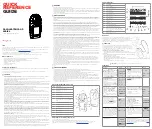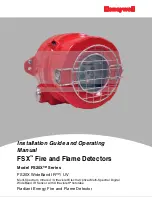
11
30
ELECTROMAGNETIC INTERFERENCE (EMI)
You are likely to encounter electromagnetic Interference (eMI) when using your Gold
Bug
®
metal detector. It is important that you recognize eMI and take appropriate
measures to deal with it. This will prevent you from giving up on a worthwhile search
site, or from returning a properly functioning detector for repair.
Symptoms of Electromagnetic Interference (EMI)
eMI can cause a metal detector to chatter spontaneously, to lose sensitivity for no apparent
reason, or to cause a periodic wobbly audio sound. What you hear will depend on what
operating mode you are using, the detector’s settings, and the source of the electrical
interference. The most common manifestation is spontaneous chatter.
All metal detectors are susceptible to eMI, but they vary in what kinds of interference
affect them. In a given environment some metal detectors may be affected by eMI
whereas others may not.
Common sources of Electromagnetic Interference (EMI)
Common sources of eMI include: overhead electric power lines, underground power lines,
other metal detectors, telephone lines carrying electronic data, computer systems, electric
fences, old CrT-based televisions, cell phones, CB and emergency communication
radios, thunderstorms, fluorescent lights, metal vapor lamps, military aircraft with electronic
warfare countermeasures turned on, electric motors, vLF military communications systems
and automobile ignition systems. At home, in a store, or in an urban environment, there
may be several different sources of interference present simultaneously.
All metal detectors generate a certain amount of internal electronic noise. The Gold
Bug
®
is specifically designed to enable you to work into the noise. experienced users,
striving for maximum depth, often adjust the machine to search with a constant audible
background sound, and then listen through that noise for the sound of real targets.
Stricter regulations in recent years have cut down on interference from electric light
dimmers and auto ignition systems. However there has also been a proliferation of
vLF-UHF wireless communication systems (cell phones, Bluetooth, wi-fi, etc.), which
often affect metal detectors. Overall, the potential for electromagnetic Interference
(eMI) is greater than it was just a few years ago.
Modern high-end metal detectors are a lot more sensitive than older units; this also
increases your detector’s vulnerability to eMI beyond what you may be accustomed to
with an older detector. Metal detectors are by their nature designed to detect magnetic
fields, and electric current always produces magnetic fields.
Coping with Electromagnetic Interference (EMI)
The primary reason metal detectors provide a sensitivity (gain and/or threshold) control,
is so that users can reduce sensitivity in order to eliminate response to electrical
interference
. Some users are reluctant to reduce sensitivity out of fear of losing depth.
At reduced sensitivity settings, you may lose some depth, but at least you can still
search.
The Gain and Threshold knobs control the sensitivity and are your first
line of defense against EMI.
The Threshold control only applies to the All Metal Mode.
THE BASICS OF METAL DETECTING
A hobby metal detector is intended for locating buried metal objects. When
searching for metals, underground or on the surface, you have the following
challenges and objectives:
1. Ignoring signals caused by ground minerals.
2. Ignoring signals caused by metal objects that you do not want to find,
like pull-tabs.
3. Identifying a buried metal object before you dig it up.
4. estimating the size and depth of objects to facilitate digging them up.
5. eliminating the effects of electromagnetic Interference (eMI) from other
electronic devices.
Your Gold Bug
®
metal detector is designed with these things in mind.
1. Ground Minerals
All soils contain minerals. Signals from ground minerals can interfere with
the signals from metal objects you want to find. All soils differ, and can
differ greatly, in the type and amount of ground minerals present. You
therefore want to calibrate the detector to the specific ground conditions
where you are hunting. The detector incorporates automated ground
balancing which will eliminate false signals from most types of soils. To
maximize the detector’s Target Identification accuracy and depth of
detection, use the GrOUND GrAB
®
Computerized Ground Balancing
function to calibrate the detector to the ground where you are searching.
See the section on GrOUND BALANCING for details.
The Basics continued on next page
Содержание Gold Bug
Страница 2: ...2 39...






































